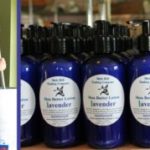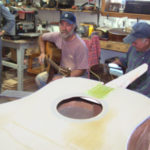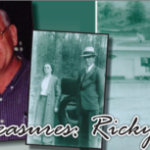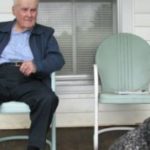
Wayne Henderson
Contributed by Big Blue Author
We all know fine craftsmanship when we see –or feel –it: the perfectly balanced hammer, the heavy-duty kitchen mixer that whips everything poured into it for 20 years, the musical instrument that makes every player sound better than he or she actually is. It seems to be a product of patience, artistry, and perhaps a touch of genius. Sometimes it comes from simple determination, bonded with practice, practice, practice. Sometimes it is all or some of these, added to careful instruction and understanding of the process of producing the final product.
Wayne C. Henderson is a fine craftsman. He is nationally and internationally recognized for his musicianship and for his craftsmanship as a luthier – a maker of stringed instruments. In a small workshop in his back yard, he produces guitars of such high quality that the waiting list is years long and the names on that list are something of an award in themselves.
Such renowned musicians as Eric Clapton and Doc Watson have Henderson guitars. Hundreds of bluegrass and old-time musicians, who have played alongside and in competition with Wayne at fiddlers’ conventions, workshops and on tours, have acquired one. And perhaps most telling of all, so has Leah Halsey, a teenager who lives across and down the road from Wayne. Leah loves music and is justifiably proud of her Henderson guitar, and while she treats it respectfully, she does take it to campouts and outdoor conventions and, occasionally, to school, where friends and acquaintances are allowed to try it out. When asked how she got her guitar while Eric Clapton was still waiting for his, Leah will smile and shrug and will perhaps mention that after Wayne promised to start on her guitar, every once in a while she would take him one of her homemade pies It seems Henderson appreciates the craftsmanship in pastry-baking as well as in making guitars.
Henderson guitars are not flashy in appearance, though some few have more and/or individually-designed inlay as ordered by the customer. Built with older Martin instruments in mind, most have light-colored spruce tops and darker, rosewood or mahogany sides and backs. To the expert, however, they are clean-looking and elegant, with hand-sanded finishes and clean, easy action of strings on frets.
Wayne will tell you that while all aspects of making a stringed instrument are important, the secret of creating a really fine one probably lies in the parts you can’t see. The top of a six-string guitar is subject to hundreds of pounds of pressure from the strings being pulled tightly from the bridge to the tuning pegs at the end of the neck. To make the sound of the instrument being played be loud enough for the player and his audience to enjoy, the top must be as thin as possible, to increase the vibration or resonance of the strummed or plucked strings. It is easier for a luthier to work with heavier wood, since mistakes can be sanded out and things aren’t as likely to break, but heavy guitars look and feel second-rate and the sound they produce isn’t pleasing. There is a trade-off, then, between strength and resonance, and the rescue is in bracing. All guitars have wooden braces glued to the inside of their tops, and the size, shape, and positioning of those braces are what can make or break a guitar.
Wayne Henderson will tell you how he learned about bracing, and about other aspects of making a wooden instrument. Henderson grew up not three miles from where he lives now, in the Rugby community of Grayson County, Virginia. His family was small-time farmers, and he was expected to follow in the tradition, but he was also following in the path his father had taken as musician. Wayne’s father played fiddle and as a young teenager, Wayne learned to play with him, moistly chording along on a borrowed guitar.
“I decided I would try to make my own guitar,” Henderson says. “It was unheard of then (in the late ‘60‘s) for someone to make a guitar by hand. My dad said there was no way I could do it. He said you could make a tool, or you could make a door or you could make a barn, but you couldn’t make a guitar. They had to come from a factory somewhere. But I thought I could figure it out.”
Henderson admired an instrument belonging to his neighbor, E. C. Ball (who later became famous for his family’s performance of tradition gospel and ballad music, and was recorded by the Library of Congress) “It was a Martin, and I just lusted after that guitar. He’d let me play it and look at it, but he wouldn’t let me take the string off it so I could get a good look inside,” Henderson recalls. “It was years later, that I heard about a fellow who was trying to repair an old Martin and I went to see it and could finally get a look at what’s inside one.”
Meanwhile, Henderson’s first attempt at a homemade guitar literally fell apart. After working on it in his spare time for most of a year, he had an instrument that looked pretty good, but when the weather turned hot and humid, the rubber cement he’d used to hold it together, gave out. “I guess my dad saw that I was pretty low about it, “Wayne says. “He told me he’d take me to see Albert Hash, to get some idea of how to make a real instrument.”
Albert Hash had been a fiddle-player in his youth, and had handcrafted a fiddle for his own use. The artistry of that instrument combined with Hash’s skill as a fiddler had made him well known in the region, but he had set it all aside when he settled to raise a family and work in a factory. During their visit, Wayne remembers Hash bringing out the fiddle and playing some tunes for him, and thanking the Hendersons for reminding him of how much he enjoyed making music. In exchange, Wayne says the contact with the generous, genuine man and the beautifully crafted fiddle unlocked several secrets for him: information about woods and “Weldwood” glue and the idea that a real instrument could be made at home, by hand.
Wayne still has the next guitar he made. He gave it a number, “1,” and he’s numbered every instrument he’s completed since. “It still plays pretty good,” he says of that first guitar (The first that stayed together, that is.) “It looks sort of rough – most of the work was done with a pocketknife.” He smiles with a combination of confession and pride.
It was with guitar #7 that the next piece of Henderson’s puzzle was solved. While still a teenager, his grandfather passed away and Wayne began spending the nights with his grandmother, whose house was a short walk down the road from his parents’. “She was afraid to be alone at night, so I’d go down there after chores every night and stay,” Wayne explains. “She didn’t get much television or anything, so I had nothing to do but either play my guitar or work on one. I’d carry the pieces down there and work at night. I’d been working on Number 7 for a long time, months and months, because I was adding a lot of fancy inlay and stuff. It was the prettiest one I’d made so far.”
Henderson explains that a neighbor came to visit at his grandmother’s house one evening, bringing a friend with him. That man asked to see Henderson’s guitar. “He played it for a long time,” Wayne says. “He could play good, and sing. He sang Hank Williams tunes, mostly.” Before he left, the man asked what Wayne would take for the guitar. Wayne, who had sold guitars number 2 – 6 to area musicians and friends for about $40 each, did not want to sell this one. He had labored long and carefully to make this one his best so far. So, not to be rude and simply reject the man’s question, he blurted out a price that he was sure was so high, no one would ever take him up on it. “Five hundred dollars. You know, back then, $500 would buy a pretty good used car. And I needed a car.”
The men left Wayne’s granny’s house, but later, the stranger returned alone. Again, he came in, asked to see the guitar, and spent the evening playing and singing. As he got up to leave, he said simply, “Well, I believe I’ll take it.” Then he pulled five one-hundred dollar bills from his shirt pocket, handed them to Wayne, and left.
Wayne says that he was stunned by the amount of cash he had in his hand – more than he might make as profit from a year of farming. “It come to me then that a person could make a living, making guitars,” he said. It was an idea that was so foreign to the time and place, that it took a while to settle in. Once it did, though, it never left.
Instead of buying a car with the money, Henderson bought some woodworking equipment and supplies, and began making guitars seriously. “I’ve been behind (in filling orders) about ever since,” he adds.
Wayne Henderson is a generous, modest man. Sitting with his in his cluttered, comfortable shop, a visitor might never guess that he’s traveled the world on performance tours, that he was named a “National Treasure,” and that one of his guitars sold at auction at Christie’s in New York for ‘way more than $500. Think of tens of thousands.
When asked point blank what he thinks makes his guitars so fine, Henderson considers carefully and then refers to the issue of craftsmanship. He’s already told us about wood and wood joints, bracing and doing every step the right way. “I guess I’m just patient.” We do not need to add, “modest.” But Wayne himself comes up with one more point. “I’m lucky because I also play music. I know what I want it to sound like, when I’m through.”
And they do.
PS Henderson guitar #7 – the first really special one that he made - has come home and now resides in the shop. Wayne Henderson will tell you that after he sold it, reluctantly, all those years ago, he and the guitar’s new owner became friends. The man, Harold Ward of Independence, Va., invited young Henderson to accompany him to fiddlers’ conventions and musical gatherings, where he introduced Wayne to other musicians and characters of all sorts. “I guess he’s sort of responsible for getting me into making music seriously,” Henderson recalls.
Wayne Henderson caught sight of that guitar for years. “Harold eventually traded it of, and I’d see it at fiddlers’ conventions, being played or leaned up against the fender of an old pickup, getting rained on. That used to bother me. Years later, somebody brought it into my shop, asking me to repair it.”
The guitar had been reduced to a sorry state by then. The front was scarred, and there was a piece of oak flooring glued to the inside, in a clumsy effort at repair. There
[`google_buzz` not found]
[`yahoo` not found]
[`livedoor` not found]
[`friendfeed` not found]











